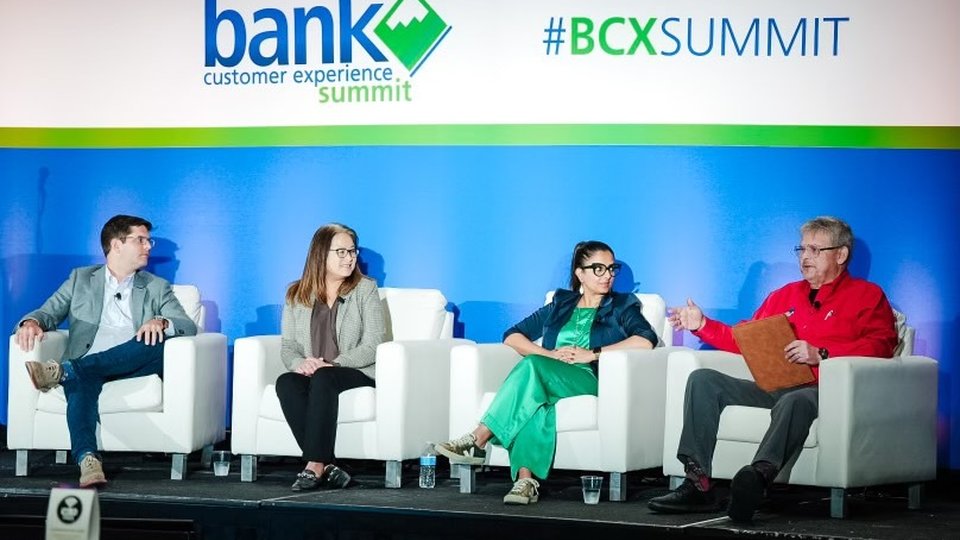Bank Customer Experience (BCX) Summit
How banks can deliver financial education successfully
Panelists at the Bank Customer Experience Summit discussed financial education in depth.

September 10, 2024 by Bradley Cooper — Editor, ATM Marketplace & Food Truck Operator
Customers aren't going to branches for simple transactions anymore. They now seek out branches for financial guidance. As a result, a big topic of discussion is how banks can revamp their branches to accommodate more financial education initiatives. But how do banks go beyond financial education to integrate it more broadly into their marketing and customer engagement strategies? This was a topic covered at a panel at the Bank Customer Experience Summit, held in Charlotte, North Carolina from Sept. 9 to 11.
John San Filippo, co-founder and publisher of Finopotamus moderated the panel with Garrett Graham, director of consumer journey at Truist Bank, Alicia Moore, head of US ATM product at Visa Global ATM and Namrata Yadav, academy executive for community advancement at Bank of America.
What is financial education?
When asked what financial education is today, Yadav said it's about "everything around financial resiliency. It's about cyber awareness, fraud, how to save, pay off credit cards and more."
Graham said it comes down to different forms of content that can reach customers in different ways. For example, Truist offers, "emails, articles, podcasts and more." For customers who want a deeper dive, they can receive larger articles.
"The way financial education is accessible to consumers is varied," Graham said.
Moore said that this advice could even be given through "very small targeted messages right from the ATM screen."
Fraud and trust
However, many customers still do not necessarily trust their banks with financial education, as Filippo pointed out. Yadav said it is absolutely crucial that banks develop better trust around financial trust, as cyber fraud is a huge issue.
She said personally that her father lost his life savings due to cyber scammers. "This is why cyber fraud is so personal to me."
Moore pointed out that AI is also making a big impact on fraud as criminals are using AI spoofing to copy the voices of loved ones and convince family members to send them money.
Graham said this is where the repetitive nature of a customer regularly getting advice from a banker will help "develop trust" over time and in turn boost ROI for these financial education programs.
Strategy
In looking at actual strategy for financial education programs, Yadav pointed out how key it is to train employees, which Bank of America does with its Better Money Habits program.
"We train our financial center managers on how to do financial education for communities, especially in low income communities. We have built these programs that everyone working through financial centers go through them," she said.
Graham said it's important to understand the reasoning behind why people do things, such as overdraw their accounts. "They know they are overdrawing their account. They are aware. The thing is important for us to understand how can we then create strategies to help them and approach it in a way that isn't shameful," Graham said.
Yadav reiterated the importance of understanding what people need based on their life stage, whether that be student, job seekers, retired and more. "We are even using VR headsets in high schools where they have financial education built into it through games," she said.
Understanding customer needs
Another way to understand what customers need is to have people in the field working with nonprofits and community organizations. Graham said they have a leadership institute to teach its leaders how to engage more efficiently with these organizations. Yadav said that Bank of America employees also volunteer with many organizations.
Moore said that with the unbanked, many of them have fintech relationships but their only real physical banking interaction is the ATM.
"Those ATMs are not sitting in banks, they are sitting at convenience stores, retail stores. That's where there they are getting their outreach. Financial education is important, but it's important to have that first conversation and those repeat conversations," Moore said.
Yadav gave another example of how Bank of America's nonprofits were telling the bank that although the digital financial education programs were fantastic, many underbanked people didn't have access to devices or the time to attend meetings. They asked if bankers could start coming to meetings for weekends or late night meetings to provide this education for communities. To meet this need, Bank of America started training employees to go out and offer this education. She said it has touched "80,000 people" so far with these expanded services.
Graham said that Truist calls such actions, "Acts of Care," which it is tracking.
The bottom line
Looking at as a marketing tool more generally, Yadav said that these digital programs are drawing in new customers, such as young people. When influencers on social media talk about financial literacy through banks, they are promoting the banks and banking in general to a younger audience.
When analyzing ROI, Moore said the primary way to track the impact of financial education is loyalty. When you provide these services, customers are more likely to be loyal. Graham agreed saying that you will only see the impact over time.
Yadav emphasized that you don't need to choose between capitalism and helping people. You can do both.








